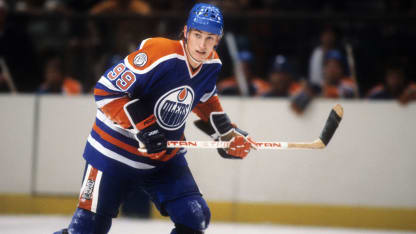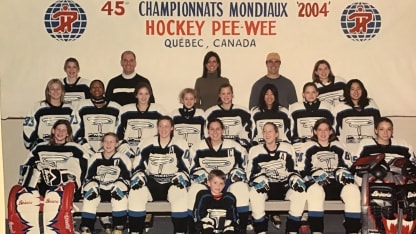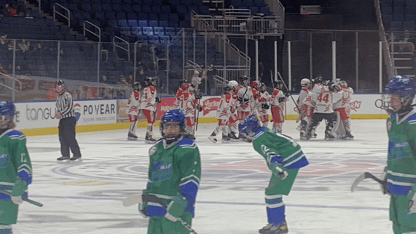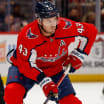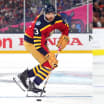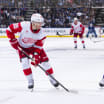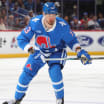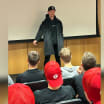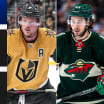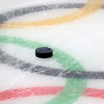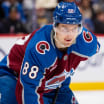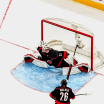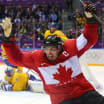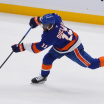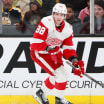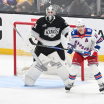Editor’s note: The Quebec International Pee-Wee Hockey Tournament has been the premier youth hockey event in Canada since 1960, a steppingstone for many future NHL players, including Wayne Gretzky and Connor Bedard. NHL.com senior director of editorial Shawn P. Roarke went to Quebec earlier this month to check out the tournament and all that goes with it. In the first of a four-part series, Roarke looks at the history and significance of the tournament.
Quebec International Pee-Wee Hockey Tournament ‘just awesome’ after 64 years
Biggest such event in world draws packed crowds, has featured many future NHL players
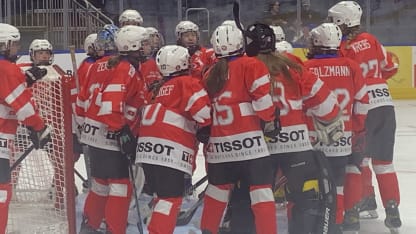
© Shawn Roarke
QUEBEC CITY -- The drama was palpable.
Close to 14,000 fans were jammed into Videotron Centre, a state-of-the art arena that is home to the Quebec Remparts of the Quebec Maritimes Junior Hockey League, to see the home team’s peewee counterparts not only take on Team Illinois, but crush it.
But what is supposed to happen doesn’t always come to fruition at the Quebec International Pee-Wee Hockey Tournament, and that is one of the reasons this annual event has become the equivalent of the Stanley Cup Playoffs for youth hockey players all across North America.
Since 1960, future NHL players -- some of them all-time greats -- have let the hockey world see just how special they are, even as 12- and 13-year-olds, at this event.
From Wayne Gretzky to Mario Lemieux to Patrick Roy to Connor Bedard, they have all made their mark here, and the tournament has done the same to them.
“You come in here and it is the one day where a kid actually feels like he's playing in the NHL,” said Jeff Turcotte, who grew up three hours away in Montreal and has coached youth hockey in California for the past 17 years, including the L.A. Jr. Kings AAA team this time. “You walk on the ice, there’s a big crowd, you know, and the kids experience what it feels like to be an NHL player.”

© Shawn Roarke
Maybe that is why so many players here find their way to the NHL.
Seven players from that first year ended up in the NHL, including 12-year-old Brad Park, who would go on to become a Hockey Hall of Fame defenseman and in 2017 was named one of the 100 Greatest NHL Players.
Fourteen years later, the tournament included 38 players who eventually reached either the NHL or the World Hockey Association. Gretzky, Paul Coffey and Larry Murphy ended up in the Hall of Fame.
In 1977, there were 31 players who would go on to reach the NHL, including Lemieux, Brett Hull, Pat LaFontaine, John MacLean, Roy, Rick Tocchet and Steve Yzerman.
There are already five players from the 2017 tournament in the NHL, and it’s a who’s who of the League’s youngest rising stars: Bedard, 18, of the Chicago Blackhawks; Logan Cooley, 19, of the Arizona Coyotes; Simon Nemec, 20, of the New Jersey Devils; Matthew Poitras, 19, of the Boston Bruins; and Juraj Slafkovsky, 19, of the Montreal Canadiens. Bedard was the No. 1 pick in the 2023 NHL Draft. Slavkofsky, Nemec and Cooley went 1-2-3 in the 2022 NHL Draft.
As soon as five years from now, players on display earlier this month could find their way to the NHL when they are eligible for the draft.
“I just remember, what hockey player doesn’t want to play in the best tournaments against the best players?” said Coffey, the former defenseman. “If you can’t play against the best players, there is no sense playing.”
For Vincent Lecavalier, a center who played 1,212 NHL games for the Tampa Bay Lightning, Philadelphia Flyers and Los Angeles Kings, his trip to the Quebec tournament with his North Shore (Montreal) team in 1994 was the first real chance to test himself against players he had only heard about from across North America.
“It was huge, honestly, because it was the kind of tournament where you knew you were playing against the best and you're 12,” said Lecavalier, who was back this season coaching his son, Gabriel, and Florida Alliance. “We were used to playing city against city in our small area, but now you're playing against everyone.
“For me it was like Rico Fata, Manny Malhotra, all these guys that they were talking about at the time. It’s like the first time that you can play against them, right? This is the only tournament that's this big and that you can actually see all the best players.”
When Lecavalier played here, the tournament was single elimination, and his team was out after one game. Today, it is double elimination, and Florida Alliance made it to the AA Elite championship game before a packed house at Videotron Centre, losing 2-1 to Ecole Fadette Vert et Noir (Quebec) on a third-period goal by Loic LeBlanc.
There’s that drama again.
In fact, among the five flights the 120 teams were divided into -- AAA, AA Elite, AA, BB and Feminin -- there was at least one game decided by a goal in the semifinals or final of each.
In the AAA bracket, the one-goal game came in the semis when the Semiahmoo Ravens defeated the Middlesex Islanders 3-2.
Semiahmoo lost 5-1 to the Mid Fairfield Jr. Rangers in the final.
For Mid Fairfield coach Sean Haggerty, it was a bit of deja vu.
He came here twice as a peewee, winning the tournament in 1989, two years after brother Ryan won it. His father, Kevin, coached each of those teams.
Ryan coached one of his boys to the championship game four years ago, losing to the Czech Knights.
Now, here was Sean Haggerty coaching his son, Braden, to a title.
“It was exciting for me personally to coach my son and win a tournament like this,” said Haggerty, who played 14 games in the NHL with the Toronto Maple Leafs, the New York Islanders and Nashville Predators from 1996-2000. “Everybody waits for this moment. There is not a lot of opportunities to get there. When you are in the hockey community and you have skin in the game, everyone knows the magnitude of the tournament.
“They just want to be a part of it in some capacity. I have multiple friends up there on different teams. Everybody walks away saying, ‘This is just awesome.’”
* * * *
Back to the Remparts peewees, who stepped onto the ice for the first time on Day 4 of the 12-day tournament, acknowledged as the best peewee team in the province.
The Remparts were the visiting team according to the center-hung jumbotron, but they were the de facto home team in this game, expected to roll past Team Illinois.
Only it didn’t happen that way.
It rarely does here.
“We put the kids out on the ice and it’s red against white and nobody knows who these kids are, but they go out and they make it into theater,” said Patrick Dom, the general manager for the tournament.
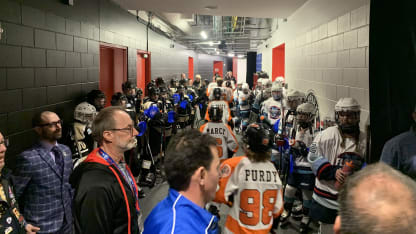
© Shawn Roarke
Team White (Illinois) and Team Red (Quebec) did just that, one of countless times theater complemented hockey in the biggest peewee tournament in the world.
In this game, Quebec defenseman Cedric Dery was the player most came to see.
“I thought he was a forward with the way he carried the puck at times,” Team Illinois coach Blake Sorenson said.
“He goes zoom like Bobby Orr,” Ghislain Berube, manager of the tournament’s museum, said before ambling off to find a seat in the packed lower bowl.
Dery did not disappoint. He was the best player on the ice for much of the game and scored the opening goal at 7:14 of the second period to put the crowd into a frenzy.
Illinois didn’t blink.
Ryan Tumilty scored 25 seconds later, then scored the game-winner with 14 seconds remaining, flicking a shot that caught the short-side post and found its way into the net.
The goal that gave Illinois a 2-1 victory set off a raucous celebration along its bench, with every word of congratulations recognizable over the suddenly silenced crowd. Grown-ups without a vested interest in the outcome sat slumped in their seats. Kids, many dressed in Remparts paraphernalia, stopped what they were doing and blankly stared at the ice.
This wasn’t supposed to happen, not to the hometown heroes. Suddenly they had lost, sent to the losers bracket and exiled from Videotron Centre to the smaller, less opulent Pavillon de la Jeunesse, the community rink a few hundred feet away. In this tournament teams stay in the Videotron until they lose. Losing teams only make it back to Videotron if they stay alive until the final rounds.
“I’m not going to lie, my heart was beating out of my chest on that goal,” Tumilty said. “I was speechless. I went to the bench, I looked up, everybody was silent. When I scored, it was pretty loud, but after that everybody was pretty zipped up. I went to the bench, we called timeout and I got all the love. That's pretty cool.”
It was a scene right out of an NHL game.
The dramatic, late goal scored by the visiting team to silence a hostile crowd was a something these kids watched so many times on their televisions and computers, their idols performing the heroics, but now it was them doing the deed.
“I knew that was the home team, so I'm hoping to be the villain and just absolutely shut them down and make the crowd go quiet,” Team Illinois goalie Tyler Senne said.
* * * *
It’s not just the hockey that is awesome, participants say.
It is everything that goes along with the tournament, which is hosted at the same time as the Quebec Winter Carnaval, a two-week outdoor celebration throughout the city.
The kids ride the famous toboggan slide and play pickup hockey on the frozen ponds when they aren’t at the rink. Many billet with local families, though it is not a requirement.
At the rinks, knee hockey and pin trading are all the rage.
Clusters of kids from various hockey teams, and various countries even, collapse on the concourse floor, huddling together and unfurling their pin collections.
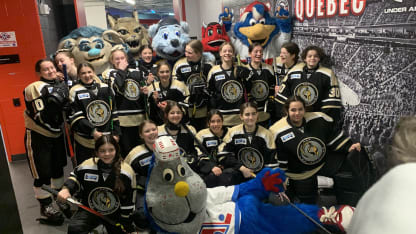
© Shawn Roarke
Traditionally, each player receives a pin from the teams they play against, and those can be traded for other pins to add to the collection, much like how kids have traded baseball cards for decades.
The pins have become larger and more intricate through the years.
Jean Labbe played in this tournament while growing up in Quebec, winning a championship pin. This time around, he was coaching his son, Tanner, with the Anaheim Jr. Ducks, a AAA team.
Before the tournament, he gave Tanner his old pins to give him a leg up on the trading.
“He told me he traded a pin with a kid and the other kid gave him four big pins for his one pin,” Labbe said. “So, he thought that he was the greatest entrepreneur. Before he did it, he called me and asked if I should do it. I asked him if he liked the pins, and he said yes. So, I told him to do it, they are your pins now.”
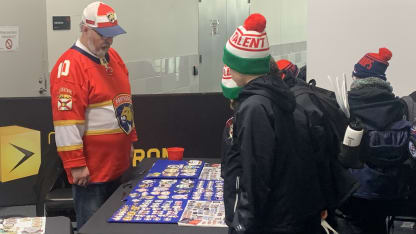
© Shawn Roarke
The soundtrack to the mayhem, on and off the ice, is the tournament theme song, which plays before each game of the tournament.
The chorus of the song is simple:
“1-2-3 go!/Pee-Wee, Pee-Wee, Pee-Wee, Pee-Wee, Pee-Wee, Pee-Wee, Pee-Wee/Vive les Pee-Wee du Carnaval!”
Those who have ever played in the tournament not only know the song, they never forget it.
Former NHL goalie Martin Biron played in the tournament in 1991 with a team from Charlesbourg, Quebec. During the 2024 tournament, he was reminiscing about playing here -- he had a shutout -- while hosting a show on SiriusXM radio. Without prompting, he broke into the song.
Lecavalier said his brother called him a week before he left for Quebec to sing him the song.
While the Florida Alliance boys and girls teams were flying to Quebec, the flight attendant congratulated all the players that were going to play in the tournament, and the rest of the plane’s passengers broke into the song.
“It was hilarious,” said Sean Ray, the girls coach for the Alliance, who has coached in the tournament seven times. “I couldn’t believe it. It brought a smile to everyone’s face.”
That is the magic the tournament weaves.
It is a community event run by volunteers and it allows young boys and girls to feel like professional players for a few days. The kids are treated like pros, enjoying perks rarely afforded to players their age.
Ray’s children are done with the tournament, having aged out long ago. But he comes back year after year and said he will coach teams at this event for as long as he is able.
What then?
“I'll be the stick guy if I have to, I don't care,” Ray said, laughing in the hallway after his team won its first game. “I'll drive the bus. Give me a role. I'm coming.”
